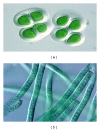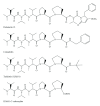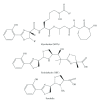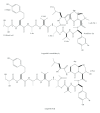Exploring marine cyanobacteria for lead compounds of pharmaceutical importance
- PMID: 22545008
- PMCID: PMC3324129
- DOI: 10.1100/2012/179782
Exploring marine cyanobacteria for lead compounds of pharmaceutical importance
Abstract
The Ocean, which is called the "mother of origin of life," is also the source of structurally unique natural products that are mainly accumulated in living organisms. Cyanobacteria are photosynthetic prokaryotes used as food by humans. They are excellent source of vitamins and proteins vital for life. Several of these compounds show pharmacological activities and are helpful for the invention and discovery of bioactive compounds, primarily for deadly diseases like cancer, acquired immunodeficiency syndrome (AIDS), arthritis, and so forth, while other compounds have been developed as analgesics or to treat inflammation, and so forth. They produce a large variety of bioactive compounds, including substances with anticancer and antiviral activity, UV protectants, specific inhibitors of enzymes, and potent hepatotoxins and neurotoxins. Many cyanobacteria produce compounds with potent biological activities. This paper aims to showcase the structural diversity of marine cyanobacterial secondary metabolites with a comprehensive coverage of alkaloids and other applications of cyanobacteria.
Figures











References
-
- Castenholz RW, Waterbury JB. Cyanobacteria. Bergey's Manual of Systematic Bacteriology. 1989;3:171–179.
-
- Smith AJ. Modes of cyanobacterial carbon metabolism. Annales de Microbiologie. 1983;134B(1):93–113. - PubMed
-
- Whitton BA. Photosynthetic Prokaryotes. New York, NY, USA: Plenum Press; 1992. Diversity, ecology and taxonomy of the cyanobacteria; pp. 1–51.
Publication types
MeSH terms
Substances
LinkOut - more resources
Full Text Sources
Other Literature Sources

